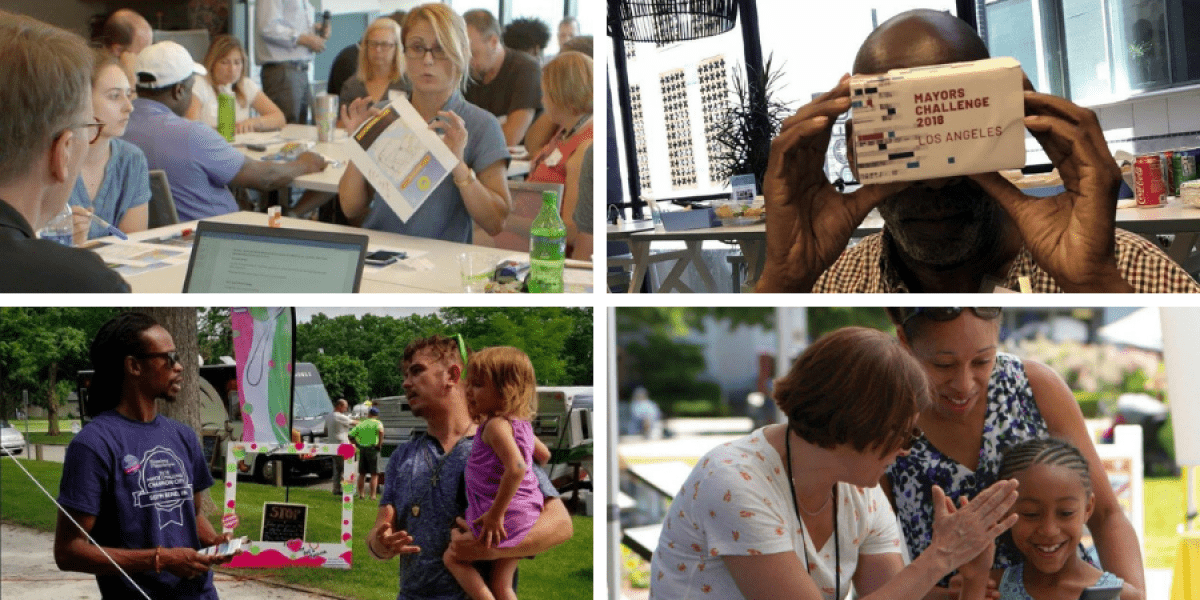Explainer: What you need to know about crowdsourcing

Seafarers of the 1700s had a big navigation problem. Calculating a ship’s east-west position in the open ocean was hard to do, and many vessels got lost at sea.
So in 1714, the British government launched the Longitude prize, putting up £20,000 (worth millions today) in the hope that someone, somewhere, might have a solution. The eventual winner — a self-taught clockmaker named John Harrison — overcame manufacturing hurdles of the time to create a portable clock that kept accurate time even on a rolling ship. Sailors could use the clock, together with observations of the sun, to figure out their distance from Greenwich.
The Longitude prize is considered one of the earliest public-sector successes with a strategy that today we call “crowdsourcing.” Essentially, the British government tapped into the knowledge and creativity of the wider public. That enabled Harrison’s innovation to bubble up and solve a problem that had vexed sailors for centuries.
Today, the basic idea behind crowdsourcing remains the same, even if the tactics in our digital age have evolved dramatically. Governments at all levels are using wikis, smartphone apps, social media, and other tools to collect ideas from residents on everything from how to liven up public spaces to what their next constitution should say.
At the same time, there’s a lot of room to grow in this area. In last year’s Bloomberg Philanthropies survey of American mayors, only 26 percent of cities said they crowdsource ideas from residents. Most examples of crowdsourcing in local government remain one-off engagements, rather than systemic re-thinking of the relationship between city leaders and residents.
What does all this mean for city leaders? In our latest explainer, Bloomberg Cities breaks down what you need to know.
What is crowdsourcing?
While the definition of crowdsourcing is still a matter of debate, a good place to start is the one used by author Jeff Howe, who coined the term in a 2006 Wired article. Howe defines crowdsourcing as “the act of a company or institution taking a function once performed by employees and outsourcing it to an undefined (and generally large) network of people in the form of an open call.”
For many, Wikipedia, the online encyclopedia anyone can edit, remains the best everyday example of crowdsourcing in action. Other common examples include crowdsourced business reviews on Yelp and traffic alerts on Waze, or, in the local government space, 311 phone lines and mobile apps that enable residents to report potholes, broken streetlights or other problems in their neighborhoods. Through tools like these, crowdsourcing is now woven into the hyperconnectivity of our lives, and especially our phones. It’s never been simpler to share our knowledge, opinions, and experiences.
While this bottom-up aspect of crowdsourcing is much discussed, the effort is typically managed by somebody, in pursuit of an organizational goal. As Daren Brabham, author of the book “Crowdsourcing in the Public Sector,” writes, “crowdsourcing is a meeting-in-the-middle of top-down and bottom-up efforts to solve problems.”
[Read: How crowdsourcing drives citizen engagement]
And while crowdsourcing can take advantage of dozens of new ways of communicating, such as wikis, blogs, websites, social media, mobile apps, or mapping software, Brabham cautions that the technology is secondary. “It is important to emphasize that crowdsourcing is a process rather than a tool,” he writes. Brabham suggests local leaders start first by considering what kind of problem they want to solve, and only then consider which crowdsourcing approach and tech tools work for the job.
Why use crowdsourcing?
Crowdsourcing can help gather ideas, insights, and data on a problem, tapping into what the author James Surowiecki called “The Wisdom of Crowds.” Simultaneously, it’s a way for city leaders to engage residents in the process of fixing the problem.
“Instead of assuming City Hall has all the answers, crowdsourcing acknowledges that residents know best what the problems are where they live,” said Stephanie Wade, who runs the innovation teams program at Bloomberg Philanthropies. “And residents often have ideas for solutions that the ‘experts’ may not have thought of.”
There are other benefits in terms of resident engagement. Crowdsourcing can be a way to get more people involved in local government than the folks who usually turn up for city council meetings. It also can bring transparency into otherwise opaque decision-making processes, and build public buy-in for change.
[Read: Explainer: What is a behavioral nudge?]
Using the strategy may also catalyze organizational learning. A recent study of four city-level crowdsourcing efforts in Poland found that local leaders generally came away more open to the opinions of residents and more willing to use technology, and that crowdsourcing “contributed to an increase in the satisfaction of the residents and employees.”
When to use crowdsourcing?
For city leaders, crowdsourcing comes into play at different stages of the problem-solving process.
One common application is to collect data in order to define a problem or understand its scope. For example, city leaders and researchers have used crowdsourcing to identify which restaurants are making people sick, to identify accessibility barriers for people with disabilities, and monitor and better understand urban noise pollution.
Crowdsourcing can also help local leaders set priorities. In Syracuse, N.Y., last year, Mayor Ben Walsh crowdsourced input on the next issue area for his innovation team to work on. Residents submitted 300 ideas, and then voted on the six most popular ones. The final pick was “housing stability” — a choice that sent the i-team looking for ways of preventing evictions and foreclosures.
Another ripe area for crowdsourcing is coming up with solutions to tough problems — that’s what the Longitude prize was all about. It’s also what San José, Calif., Mayor Sam Liccardo did with his “Unleash Your Geek” challenge. Hoping to tap into the Silicon Valley tech talent in his city’s backyard, Liccardo asked residents to come up with innovative solutions to problems like graffiti removal. The winners of that challenge developed a drone that can erase graffiti from tall buildings or highway overpasses.
Who’s in the crowd?
When local governments apply crowdsourcing, one key question is whether members of the “crowd” require any particular expertise. Often, they don’t. That was the case in Syracuse: The city aimed to reach as many residents as possible, and ultimately engaged about 1,000 people. The only expertise necessary was the experience of living one’s life in the city.
Other times, more knowledge is needed. While anyone could enter San José’s Unleash Your Geek challenge, the intention was to tap into the local university and civic tech communities. Then there’s the “Smarter Crowdsourcing” initiative from NYU’s GovLab. For projects such as tackling corruption in Mexico, the initiative curates global groups of subject-area experts for online meetings focused on coming up with innovative ideas that can be put into practice.
[Read: Explainer: What is ‘human-centered design’?]
In all cases, a cardinal rule of crowdsourcing is to assemble as diverse a crowd as possible. That ensures a wide variety of perspectives are represented. One way to do that is to use multiple forms of outreach — and to look beyond tech-based approaches. In Syracuse, residents could send in ideas by social media or through a popular local listserv — but they also could attend public meetings and jot down ideas on sticky notes. When it came time to vote, residents could do it online, or with a paper ballot at a library or community center.
What are limitations of crowdsourcing?
Asking the crowd though, isn’t always best. Their views can be colored by bias, influenced by other members of the crowd, or skewed by self-selection. A recent study of crowdsourced hospital ratings on Facebook, Google, and Yelp, for example, found the sites are not very good at measuring clinical quality or patient safety.
In other words, crowdsourced information needs to be considered alongside other factors. That’s what Syracuse did in picking an issue area for the city’s i-team to work on. While the crowd’s first pick was to fix more sidewalks, the city already had a repair operation in place. After consulting with the i-team and city council, Mayor Walsh chose the crowd’s second pick — housing stability — because it stood to benefit more people who are struggling.
“Crowdsourcing alone does not solve a problem,” Wade said. “You still need to understand the root causes of the problem. Social challenges are complex and need to be solved systemically. Residents’ experiences and perspectives are key, and need to be looked at alongside the experiences of all stakeholders involved.”
GovLab Director Beth Simone Noveck, a proponent of public-sector crowdsourcing, said several factors are holding it back. “Bureaucracies are very resistant to change,” Noveck wrote recently in the Washington Post. “Nor do politicians or public servants typically want to engage us. After all, there is little political will to do something that could result in a loss of power.”
Where is crowdsourcing headed?
Noveck sees a future where city councils will more systematically use crowdsourcing to improve the quality of lawmaking — a method she calls “CrowdLaw.” Already, there are good examples of this in action, such as Mexico City’s crowdsourced constitution and Taiwan’s open consultation process for discussing national issues both online and off.
The challenge is scaling initiatives like these into truly transformative new ways of governing. Geoff Mulgan, head of the U.K.’s Nesta, envisions tapping into something larger: “collective intelligence.” In his book “Big Mind,” Mulgan argues that governments, among other organizations, can draw on both the brainpower of crowds and the computing power of machines to solve complex problems.
It’s possible to imagine governments “using data from many sources, drafting policies and laws more openly, predicting possible effects, and ensuring much more transparent scrutiny of effects achieved,” Mulgan writes. “The building blocks for all of these already exist,” he says, but “nowhere are they brought together into a deliberate design for collective intelligence in government.”
For the bulk of cities who have little to no experience with crowdsourcing, the logical next step is just to give it a try. Brabham says that will require money to build or buy the tech tools used for crowdsourcing, and staff time to manage the efforts. But it’ll be worth it for smaller governments to gather “the guts to give crowdsourcing a try,” he says.
“As our attitudes change, and as technology changes, so, too, do our expectations for a relationship with our government and our place in it change.”
Read more explainers from Bloomberg Cities:



